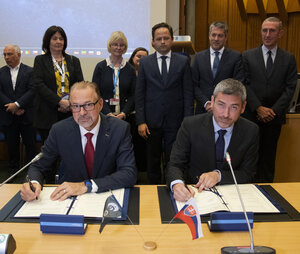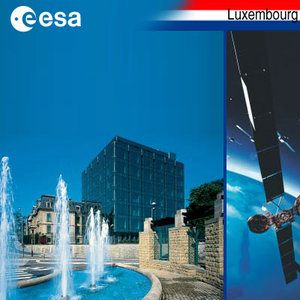Slovakia becomes ESA Associate Member state
Following its unanimous approval by ESA Council on 17 March, the Association Agreement between ESA and the Slovak Republic was signed on 14 June at ESA ESTEC in Noordwijk, The Netherlands.
Delegations from the 22 Member States witnessed the signing ceremony, with ESA Director General Josef Aschbacher and the former State Secretary in charge of space affairs within the Slovakian Ministry of Education, Science, Research and Sport, Mr Ľudovít Paulis.
On that same day, Mr Paulis also had the opportunity to meet Senator Bill Nelson and Ms Pamela Melroy, who jointly delivered an address to Council on behalf of NASA.
Slovakia’s Associate membership came into effect on 13 October, for an initial duration of seven years, following the exchange of notifications of the completion of internal procedures for the entry into force of the Association Agreement. The latter was approved by the Parliament, and the instrument of ratification signed by the President of the Slovak Republic, Ms Zuzana Čaputová on 12 October, testifying to the unwavering political commitment to space activities, since the first bilateral Agreement concerning space cooperation for peaceful purposes, dating back to 2010.

The Association Agreement supersedes the European Cooperating State (ECS) Agreement, which entered into force upon Slovakia’s subscription to the Plan for European Cooperating States Charter on 4 February 2016, a scheme introduced at ESA in 2001. The ECS Agreement was subsequently extended until 3 August 2022. During this period, 67 projects with an average value per contract of €150 000 were selected for implementation, through seven calls for proposals and for a planned budget amounting to €14.5 million. Several activities are still ongoing.
Reiterating his strong commitment to make space for everyone and to promote a balanced growth of the ecosystem, the Director General congratulated the new Minister of Education, Science, Research and Sport, Mr Ján Horecký, and warmly welcomed Slovakia as Associate member.
“The expertise and knowhow gained through the continued development of space programmes, the competitive industrial capacity built over time, as well as newcomers’ niche approach to innovation, are key to successfully step-up Europe’s ambitions in space,” said the Director General.
“I would like to pay tribute to all those involved, to the government, to the Slovak Space Office, the Delegation to ESA, both headed by Ms Jana Rovňanová, and to Mr Michal Brichta, leading the industry branch, for the efforts undertaken in terms of governance, funding, industrial policy and international networking, under the cooperation with the agency,” he continued.

An 'expert seminar' took place in Paris on 21 September on the occasion of the 73rd International Astronautical Congress. Mr Michal Brichta presented to international partners, Slovak SMEs and start-ups, such as 3IPK, Astros Solutions, Spacemanic, Touch4IT, ABmerit and Needronix. This was followed by a reception hosted by HE Mr Igor Slobodník, Slovakia's Ambassador to France, to celebrate the association with ESA.
The level of support provided is set to increase, with a view to securing a successful integration of Slovakia in the frame of ESA, the further development of sustainable space capabilities, and their involvement in the European supply chain. The exchange of experts and information will help achieving these goals. With respect to the geographical distribution of contracts, ESA will strive at providing a fair industrial return to Slovakia. The preferred use of European space transportation systems, facilities, products and services belonging to, developed or operated under the auspices of ESA or its Member States, is also stipulated.
As a member of the European Union since 1 May 2004, Slovakia is already associated to the definition of an overall European Space Policy and participates in the EU Galileo and Copernicus programmes. Slovakia is now entitled to benefit from most ESA Basic Activities executed under the General Budget, and to provide scientific experiments or observation facilities to the mandatory programme.
Slovakia builds on a long tradition in the fields of astronomy and space research. A Moon crater has been named after Maximilián Rudolf Hell (1720-92), while Milan Rastislav Štefánik (1880-19) was awarded the Jules Janssen prize from the French Astronomical Society in 1907. The Lomnický Štít Observatory has played a significant role in mapping the stars, resulting in the discovery of the planet ‘1807 Slovakia’ in 1971. Since then, researchers and engineers have been contributing to major international missions such as Rosetta, BepiColombo and the Jupiter icy moons explorer Juice.
Slovak representatives will be entitled to attend meetings of ESA Council and its subordinate bodies, and to vote on questions relating to the activities and programmes in which Slovakia participates, in its capacity of Participating State in the case of optional programmes. A training session was delivered to that effect in Bratislava on 23 August. At the next Council meeting at Ministerial level to be held on 22-23 November in Paris, the government intends to subscribe to Technology, Earth Observation, and Space Safety programmes.
‘Terrae Novae’ might be considered at a later stage, as potential contributions focusing on biotechnology, life-support systems, additive manufacturing and robotic exploration have surfaced. Here also, Slovakia benefit from their legacy in human spaceflight. Vladimír Remek was the first non-Soviet, non-American person to travel into space, in 1978. Launched in the framework of the Intercosmos programme as Czechoslovak, he flew aboard Soyuz 28 to the Salyut 6 space station. Ivan Bella became the first Slovak to fly in space, as part of the joint ‘Štefánik’ mission to the Mir space station, in 1999.

Participation in ‘ScaleUp’, an ESA framework established to boost innovation and commercialisation, will support the development of economic operators in new and emerging space markets. In addition, ‘Requesting Party Activities’ will be conducted as an incentive scheme. Partnering with European companies involved in consortia under Horizon Europe at EU level would also be key to further develop the domestic industrial base.
According to the space industry index (‘Space Industry in Slovakia’), more than 40 companies have been actively involved in the space economy so far. Most of the revenue comes from software applications using Galileo or Copernicus data. Upstream activities cover mainly spacecraft and ground-based telescope components, as well as nanosats.
The first Slovak satellite (skCUBE), launched on 23 June 2017 from the Satish Dhawan Space Centre in Sriharikota, India, was developed and manufactured by the University of Žilina, the University of Technology of Bratislava, and the Slovak Organisation for Space Activities.
The CubeSat payloads selected for deployment during the Ariane 6 maiden flight include GRBBeta, a gamma ray burst detector comprising an advanced altitude determination device and a satellite-to-satellite communication system.
Launched on 22 March 2021 on a Soyuz from Baïkonur, GRBAlpha was built through a collaboration led by the Konkoly Observatory of the Eötvös Loránd Research Network along with Hiroshima and Nagoya Universities (Japan), Spacemanic s.r.o. and Needronix s.r.o. from Slovakia, Eötvös University (Hungary), and Masaryk University (Czech Republic) while the launch contract and radio license were provided by the Technical University of Košice.
Both are 1U CubeSat missions to demonstrate the detector technology and electronics for the future ‘Cubesats Applied for Measuring and Localising Transients’ (CAMELOT) constellation of nanosatellites providing all-sky coverage with high sensitivity and localisation accuracy following detections of gamma-ray transients.

Over 50 additional companies could enter the space sector, building on their strong know-how in electronics, high-precision machinery, industry 4.0 and ICT. A dozen of them were attracted lately, through sector-entry consultancy and matchmaking activities. A space incubator connecting three regional HUBs (Bratislava, Žilina and Košice) was launched by the Slovak Investment and Trade Development Agency under the auspices of the Ministry of Economy. GOSPACE Tech, M2M Solutions, 3IPK, Deutsche Telekom IT Solutions Slovakia, and the Institute of Experimental Physics of the Slovak Academy of Sciences are among the entities solicited. As a new Associate member, Slovakia will also benefit from ESA’s network of Business Incubation Centres.
Awareness raising campaigns, educational activities, as well as university courses are developed in parallel, to forge a suitably educated workforce. Building synergies between academia and industry, partnering at regional and international levels, within the Visegrád Fourgroup, and beyond, are among Slovakian headline objectives. A member of the UN Committee on the Peaceful Uses of Outer Space since 1958 as part of Czechoslovakia, Slovakia later joined Eutelsat IGO, Eumetsat, the intergovernmental Group on Earth Observations and Eurisy. The Slovak Academy of Sciences plays an active role in both the Committee on Space Research and the International Astronautical Federation. Distinguished scholars and practitioners are also involved in the International Academy of Astronautics.
ESA has now established formal relations with all EU members not Member States of ESA. Through the ‘Resolution on industrial policy measures to achieve a successful integration of European States in the frame of ESA’, adopted by Council on 13 December 2018, an improved cooperative approach designed for European states with a view to their possible accession to the Convention was introduced.
Associate membership is a special status granted under Article XIV.1 and XIV.3 of the ESA Convention. The initial purpose was to make the non-Member State aware of the ESA’s programmes and activities at an early stage with a view to lead to a progressive strengthening of the bilateral relations. The first Association Agreements were signed with Austria and Norway, in 1979 and 1981 respectively, for a five-year period and were thereafter extended in 1984 and 1985, pending the finalisation of the accession to the ESA Convention procedure for both States in 1987.
A slightly improved Association led to a smooth and successful integration of Finland into ESA in 1995. Since then, three other Association Agreements have been concluded, with Slovenia in 2016 (a ‘reinforced’ Association was introduced in 2020), Latvia in 2020 and Lithuania in 2021. New ECS Agreements with Bulgaria and Cyprus entered into force in 2022. General cooperation agreements have been concluded with Malta in 2012 and Croatia in 2018.
ESA Member States, our Director General and staff are very much looking forward to the concrete implementation of the Association Agreement, through Slovakia’s steadily extending participation in ESA’s programmes, activities, official meetings and educational projects.
For more information
Ms Nathalie Tinjod
European and External Relations Department
ESA Headquarters, Paris
Email: Nathalie.tinjod @ esa.int
Mr Stephen (Phil) Airey
Industrial Policy and Auditing Department
ESA ESTEC, Noordwijk
Email: Stephen.Airey @ esa.int















 Germany
Germany
 Austria
Austria
 Belgium
Belgium
 Denmark
Denmark
 Spain
Spain
 Estonia
Estonia
 Finland
Finland
 France
France
 Greece
Greece
 Hungary
Hungary
 Ireland
Ireland
 Italy
Italy
 Luxembourg
Luxembourg
 Norway
Norway
 The Netherlands
The Netherlands
 Poland
Poland
 Portugal
Portugal
 Czechia
Czechia
 Romania
Romania
 United Kingdom
United Kingdom
 Slovenia
Slovenia
 Sweden
Sweden
 Switzerland
Switzerland










































